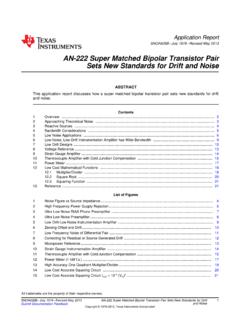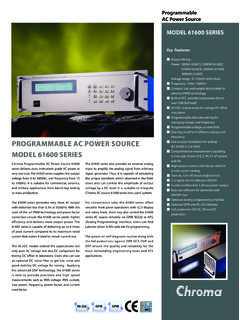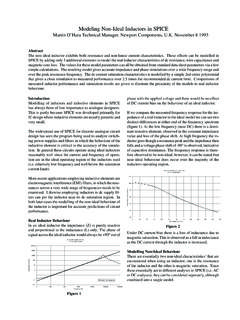Transcription of The self-resonance and self-capacitance of solenoid coils
1 1 The self - resonance and self - capacitance of solenoid coils :applicable theory, models and calculation David W Knight1 Version2 , 4th May : Abstract The data on which Medhurst's semi-empirical self - capacitance formula is based are re-analysed in away that takes the permittivity of the coil-former into account. The updated formula is compared with theories attributing self - capacitance to the capacitance between adjacent turns, and also with transmission-line theories. The inter-turn capacitance approach is found to have no predictive power.
2 Transmission-line behaviour is corroborated by measurements using an induction loop and a receiving antenna, and by visualising the electric field using a gas discharge tube. In-circuit solenoid self - capacitance determinations show long-coil asymptotic behaviour corresponding to a wave propagating along the helical conductor with a phase-velocity governed by the local refractiveindex ( , v = c if the medium is air). This is consistent with measurements of transformer phase error vs. frequency, which indicate a constant time delay.
3 These observations are at odds with the fact that a long solenoid in free space will exhibit helical propagation with a frequency-dependent phase velocity > c. The implication is that unmodified helical-waveguide theories are not appropriate for the prediction of self - capacitance , but they remain applicable in principle to open-circuit systems, such as Tesla coils , helical resonators and loaded vertical antennas, despite poor agreement with actual measurements. A semi-empirical method is given for predicting the first self - resonance frequencies of free coils by treating the coil as a helical transmission-line terminated by its own axial-field and fringe-field capacitances.
4 Keywords: circuit modelling, solenoid coil, self - capacitance , self - resonance , helical waveguide, sheet helix, sheath helix. Acknowledgements I would like to thank Prof. Tuck Choy (M0 TCC) for detailed reading and discussion of this work, and for providing reference materials and corrections. I would also like to thank Bob Weaver for discussions, corrections, inductance calculation programs, and reference materials; Alex Pettit (KK4VB) for the long coil measurements discussed in the text; Dr Duncan Cadd (G0 UTY) for the donation of a large PTFE-cored test coil; and Dr Richard Craven for discussions and for introducing me to the literature on folded helical St Mary, Devon, UK.
5 Website: check the author's website for updates and supplementary material. D. W. Knight, 2009 - 2016. 2 ContentsAbstract ..1 Acknowledgements .. The inductor modelling problem .. Scattering experiment .. Conductor length vs. SRF .. Single-conductor transmission-line .. Normal-mode antennas and Tesla coils .. Helical resonators .. Helical waveguide models overview .. Velocity-factor for a finite free helix ..23 Simple fringe-field correction ..27 Decline of velocity factor with frequency.
6 Velocity factor for an infinite free helix ..30 Kandoian & Sichak .. self - capacitance .. Propagation of uncertainty from SRF to self - capacitance .. self - capacitance derived from the conductor-length ..413. Medhurst's formula ..43 Repeat of Medhurst's data analysis ..444. Coil-former dielectric ..455. Empirically-corrected formula for self - capacitance ..506. Inter-turn capacitance ..537. Comparison of self - capacitance formulae ..558. Tubular coil formers ..609. Axial induced electric-field capacitance .
7 62 Correction for internal dielectric ..6510. Velocity limiting ..7011. Free coil SRF calculation ..77 Helical-line surge resistance ..79 Uniform current surge resistance ..80 Nominal VF - short coil limiting case ..81 Nominal VF - Iterative solution ..83 Pitch-angle correction ..88 Long-coil correction ..89 Coil former dielectric ..91 Model properties, limitations and overall calculation procedure ..9512. Pseudo self - capacitance ..9813. Discussion and summary ..101 Glossary ..103 Revision history.
8 The inductor modelling problem Of the circuit theory elements: resistance, capacitance and inductance; the latter is the least amenable to realisation in practical devices. The reason is that the lumped-component theory depends on the assumption that every physical dimension is negligible in comparison to the operating wavelength. In a wound inductor, the difficulty lies with the length of the piece of wire inside it. Although that wire might be coiled-up in a small volume, its full length nevertheless dictates the inductor's high-frequency behaviour.
9 When a solenoid coil is operated in the regime in which wire length is negligible in comparison to wavelength, its partial inductance3 can be calculated with good accuracy from magnetic considerations alone. A straightforward basis for so doing is the hypothetical current-sheet inductorthat, with corrections for realistic wire, allows the inductance of coils of small pitch-angle to be determined from physical parameters to an accuracy of around one part-per-thousand4. Magnetic theory must, of course, be respected in the asymptotic behaviour of any hypothesis that purports to describe inductors at high frequencies, and this has been a weakness in some of the more influential studies.
10 At audio and low-radio frequencies, the situation is complicated by the onset of the skin effect, and its companion, the proximity effect. The internal impedance of isolated wires is however fairly easy to calculate5; and the proximity effect, albeit more difficult to quantify, is nevertheless susceptible to attack6 7. We can also note that the redistribution of electric current that affects external inductance is physically constrained; , the loop radius is always determined to a point that lies within the body of the conductor.







